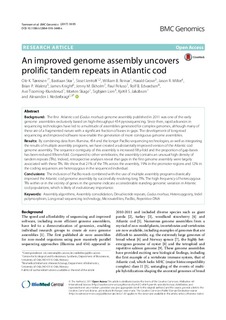| dc.contributor.author | Tørresen, Ole K | |
| dc.contributor.author | Star, Bastiaan | |
| dc.contributor.author | Jentoft, Sissel | |
| dc.contributor.author | Reinar, William B | |
| dc.contributor.author | Grove, Harald | |
| dc.contributor.author | Miller, Jason R | |
| dc.contributor.author | Walenz, Brian P | |
| dc.contributor.author | Knight, James | |
| dc.contributor.author | Ekholm, Jenny M | |
| dc.contributor.author | Peluso, Paul | |
| dc.contributor.author | Edvardsen, Rolf B | |
| dc.contributor.author | Tooming-Klungerud, Ave | |
| dc.contributor.author | Skage, Morten | |
| dc.contributor.author | Lien, Sigbjørn | |
| dc.contributor.author | Jakobsen, Kjetill S | |
| dc.contributor.author | Nederbragt, Alexander J | |
| dc.date.accessioned | 2018-03-13T09:55:35Z | |
| dc.date.available | 2018-03-13T09:55:35Z | |
| dc.date.issued | 2017 | |
| dc.identifier.citation | BMC Genomics. 2017, 18:95 1-23 | nb_NO |
| dc.identifier.uri | http://hdl.handle.net/11250/2490248 | |
| dc.description.abstract | Background The first Atlantic cod (Gadus morhua) genome assembly published in 2011 was one of the early genome assemblies exclusively based on high-throughput 454 pyrosequencing. Since then, rapid advances in sequencing technologies have led to a multitude of assemblies generated for complex genomes, although many of these are of a fragmented nature with a significant fraction of bases in gaps. The development of long-read sequencing and improved software now enable the generation of more contiguous genome assemblies. Results By combining data from Illumina, 454 and the longer PacBio sequencing technologies, as well as integrating the results of multiple assembly programs, we have created a substantially improved version of the Atlantic cod genome assembly. The sequence contiguity of this assembly is increased fifty-fold and the proportion of gap-bases has been reduced fifteen-fold. Compared to other vertebrates, the assembly contains an unusual high density of tandem repeats (TRs). Indeed, retrospective analyses reveal that gaps in the first genome assembly were largely associated with these TRs. We show that 21% of the TRs across the assembly, 19% in the promoter regions and 12% in the coding sequences are heterozygous in the sequenced individual. Conclusions The inclusion of PacBio reads combined with the use of multiple assembly programs drastically improved the Atlantic cod genome assembly by successfully resolving long TRs. The high frequency of heterozygous TRs within or in the vicinity of genes in the genome indicate a considerable standing genomic variation in Atlantic cod populations, which is likely of evolutionary importance. | nb_NO |
| dc.language.iso | eng | nb_NO |
| dc.publisher | Biomed Central | nb_NO |
| dc.rights | Navngivelse 4.0 Internasjonal | * |
| dc.rights.uri | http://creativecommons.org/licenses/by/4.0/deed.no | * |
| dc.title | An improved genome assembly uncovers prolific tandem repeats in Atlantic cod | nb_NO |
| dc.type | Journal article | nb_NO |
| dc.type | Peer reviewed | nb_NO |
| dc.description.version | publishedVersion | nb_NO |
| dc.source.pagenumber | 1-23 | nb_NO |
| dc.source.volume | 18 | nb_NO |
| dc.source.journal | BMC Genomics | nb_NO |
| dc.source.issue | 1 | nb_NO |
| dc.identifier.doi | 10.1186/s12864-016-3448-x | |
| dc.description.localcode | nivå1 | nb_NO |

